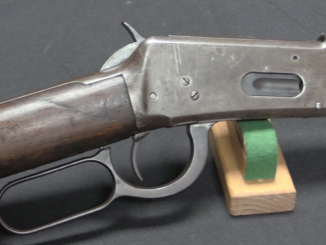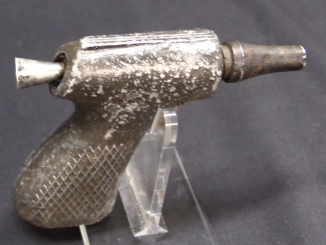PTR’s new “Vent” line of suppressors are a really cool use of new technology to better execute an old design concept. The idea is that forcing muzzle gasses through a porous material will work well to slow and cool them, providing good sound suppression. Back in the 1940s (through the 60s or 70s), this was done with wire mesh rolled into a tube. Today, PTR is following the same principle to a much finer degree by using additive manufacturing to produce titanium with “purposely induced porosity”. Essentially, titanium foam. Their design is furthermore done to minimize back pressure, allowing guns to run suppressed without modification and for shooters to not get a lot of noxious exhaust in the face. And on top of all that, the suppressors are quite light. What’s not to like?
Well, the price, for one thing. In addition, these cans require periodic cleaning, unlike most centerfire suppressors. PTR suggests soaking them (or better, using an ultrasonic cleaner) every 1000 rounds for pistol cartridges and every 1500 rounds for rifle cartridges. This is necessary to prevent the porous titanium from clogging up with carbon.
Is that a worthwhile tradeoff? Well, that depends on each person’s specific desires and needs.
Pew Science report on the 9mm Vent 2:
https://pewscience.com/sound-signature-reviews-free/sss-6-131-ptr-vent-2-sp5
Pew Science report on the 5.56mm Vent 3:
https://pewscience.com/sound-signature-reviews-free/sss-6-135-ptr-vent-3-mk18-556




Too bad that the spongy part would be regulated just as severely as rest of the can. Otherwise they could market a cheap, replaceable gas absorption core made of something like rolled steel screen that wasn’t as painful as titanium.
Great way to state the obvious, Dang, but you’re taking the conversation from one about new technology to one about regulatory issues. If suppressors are such a pain to maintain, shouldn’t our goal be to make them easier to make last? What solvents won’t eat titanium, for example?
Thank you for highlighting PEW Science laboratory research!
These new silencer technologies are really interesting – we’re living in very great times for suppressed weapon systems!
I’ve always heard that any kind of foam filled supressor was illegal on firearms. Has this changed?
It’s not actually foam, just titanium printed in a 3D porous shape to mimic foam. But unlike the cans that use liquids to mitigate velocity of expanding gases, these last longer than a couple of shots. But even if you filled your suppressors with Redi-Whip, it wouldn’t be classified as a component. Despite the wacky rules.
That is why the U.S. is dying. You ask “May I?” not “Where can I buy one?” Your Second Civil War is already long underway while you fret and fritter
And we have a winner for the dumbest ass on the internet.
“They’re already at war on us” is the language used by the right-wing Malays in Indonesia in 1966 as they went out with their machetes to murder 600,000 of their Chinese and leftist neighbors. Likewise the Hutus in Rwanda. And doubtless any number of racist genociders pretending that their first strike was just self-defense. Blame the government, but then take out your stockpile of private weapons to murder your neighbors instead. That’s how it will be here because that’s already happened here before.
Add up the terrorist killings over ideology by Americans, and tell me who’s already waging war.
Well, gasoline, for one. The next issue becomes how much combustible material remains embedded in the porous metal core and what happens when it ignites. Would that action degrade the core? Who knows. Would ultrasonic cleaning be safer? Maybe. Is this thing way too expensive to take chances with? Absolutely. Why am I talking to myself? Where’s Daweo? Where Col. Beausabre? How is nobody else discussing this?
Dang, you gave a great idea, I’d love to see it filled with gasoline and shot. Youtube vid winner
Yeah, I really want to try that, just not on my own suppressor. Or one I paid for.
“(…)Back in the 1940s(…)purposely induced porosity(…)”
My cursory patent search revealed that idea of suppressing fire-arms using porous material date at least back to 1920s
1929 GB312937A Silencer for exhaust and other pulsating gases and vapours …mineral fibre, metallic shavings, mica, slagwool, pumice and the like
1936 GB463925A Silencers for internal combustion engines and machine guns …material is composed of glass wool treated so that the entangled threads are firmly interconnected, preferably at their points of contact, so as to form an elastic and porous structure. For this purpose, the glass wool is treated with a binding-agent which is so diluted that the resiliency of the glass threads maintains the relative distances between them during the evaporation of the solvent. Gelatine, dextrin, silicates, and in the case of cold gases also latex, are suitable for . the impregnating-agent…
1936 DE629404C Schalldaempfer fuer Handfeuerwaffen porösen Stoff, wie Viscoseschwamm, Gummischwamm oder ähnlichem
Interestingly first of them was filled by CF Burgess Laboratories Inc, which seems to more close for silencers used in automobiles https://historicimages.com/products/rrs06309
which lead to question if materials used inside automobile silencers could be appropriated for purposed of fire-arms suppressing?
porous aluminum silencer all the way back in the 60s- see the Frankford arsenal entry here:
https://photos.app.goo.gl/Pu7Ku2moxfdu4v8X7
I don’t see the need to clean the suppressor after 1000/1500 rounds as a big deal. Somebody who shoots that much and is offended by having the clean the suppressor, probably is not going to clean their gun after that many rounds. So they deserve everything fouling up.
Marketing Manager: Let’s give Ian our new product and hope he does not trash it.
Gotta wonder if Ian ever thought his hobby would turn him into someone that companies would risk a bad review from, just because his audience reach is so great.